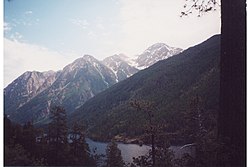This article's use of external links may not follow Wikipedia's policies or guidelines.(April 2023) |
This list includes significant mountain peaks located in the United States arranged alphabetically by state, district, or territory. The highest peak in each state, district or territory is noted in bold. For state high points that are not mountains, see List of U.S. states and territories by elevation.
Contents
- Significant mountain peaks and high points
- Alabama
- Alaska
- American Samoa
- Arizona
- Arkansas
- California
- Colorado
- Connecticut
- Georgia
- Guam
- Hawaiʻi
- Idaho
- Illinois
- Kansas
- Kentucky
- Louisiana
- Maine
- Maryland
- Massachusetts
- Michigan
- Minnesota
- Mississippi
- Missouri
- Montana
- Nebraska
- Nevada
- New Hampshire
- New Jersey
- New Mexico
- New York
- North Carolina
- North Dakota
- Northern Mariana Islands
- Ohio
- Oklahoma
- Oregon
- Pennsylvania
- Puerto Rico
- South Carolina
- South Dakota
- Tennessee
- Texas
- Utah
- Vermont
- Virgin Islands (U.S.)
- Virginia
- Washington
- West Virginia
- Wisconsin
- Wyoming
- Summit disambiguation
- See also
- References
- External links
















































































